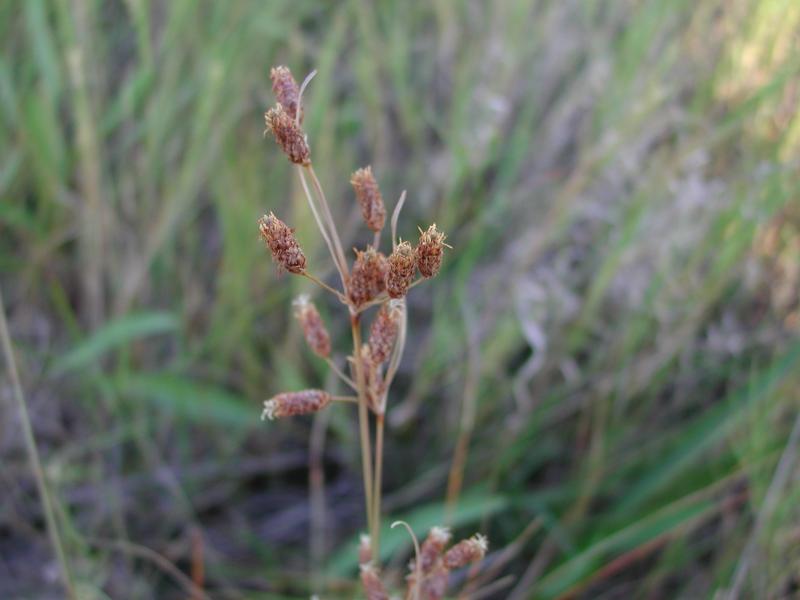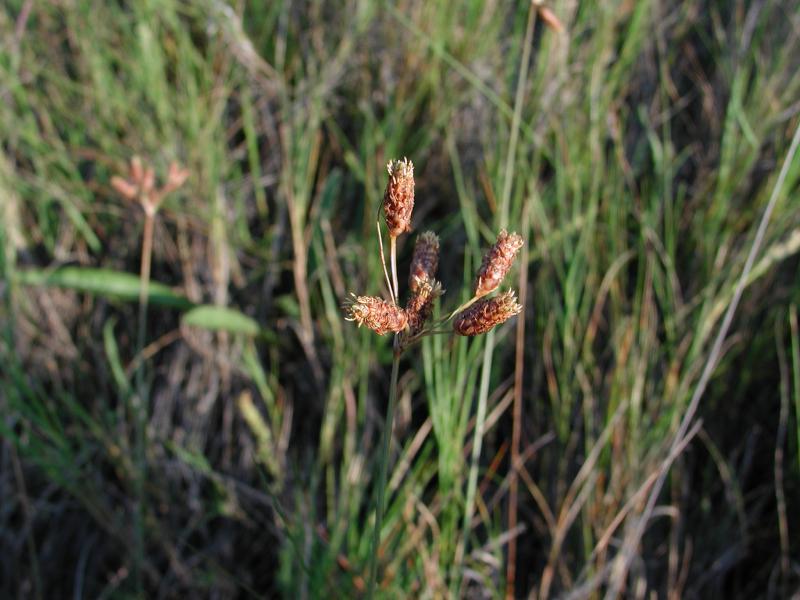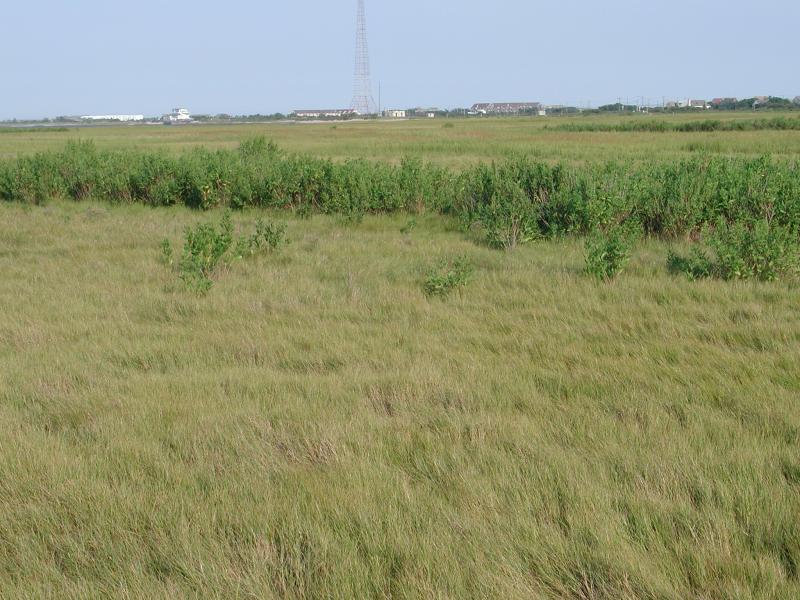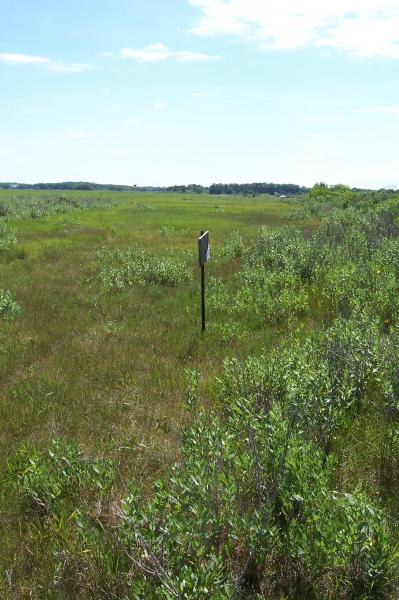Marsh Fimbry
Fimbristylis castanea (Michx.) Vahl
- Class
- Monocotyledoneae (Monocots)
- Family
- Cyperaceae (Sedge Family)
- State Protection
- Threatened
Listed as Threatened by New York State: likely to become Endangered in the foreseeable future. For animals, taking, importation, transportation, or possession is prohibited, except under license or permit. For plants, removal or damage without the consent of the landowner is prohibited.
- Federal Protection
- Not Listed
- State Conservation Status Rank
- S2
Imperiled in New York - Very vulnerable to disappearing from New York due to rarity or other factors; typically 6 to 20 populations or locations in New York, very few individuals, very restricted range, few remaining acres (or miles of stream), and/or steep declines.
- Global Conservation Status Rank
- G5
Secure globally - Common in the world; widespread and abundant (but may be rare in some parts of its range).
Summary
Did you know?
The genus name means fringed style and the species name refers to the dark brown, or castaneous, leaf bases (Flora of North America Editorial Committee 2002).
State Ranking Justification
There are ten existing populations and most of them have over 100 plants with one very large population of thousands of plants. There are three additional populations from the early 1900s that have not been rediscovered and three populations from the late 1800s which are considered extirpated.
Short-term Trends
Most of the populations have been doing well in the short term. There have been no recent surveys of the smaller populations to determine trends.
Long-term Trends
This plant has always been rare in New York and while 3 populations are considered extirpated others have been rediscovered. The trend may be downward in the future without control of Phragmites.
Conservation and Management
Threats
The invasion of Phragmites is the largest threat at this time. One population is subject to trampling of the salt marsh.
Conservation Strategies and Management Practices
Control Phragmites invasions in the salt marshes where it exists and prevent new incursions. Natural buffers should be established around the salt marshes to decrease pollution runoff and other direct human disturbances.
Research Needs
There is a need for research into the factors that control the population size of this plant.
Habitat
Habitat
In New York, marsh fimbry has been found exclusively in high salt marshes, often at the landward edge, and in adjacent areas of open salt shrub vegetation (New York Natural Heritage Program 2010). Salt marsh and brackish marsh inland (FNA 2002). Brackish coastal marshes, seldom in alkaline sites inland (Gleason and Cronquist 1991).
Associated Ecological Communities
- High salt marsh
(guide)
A coastal marsh community that occurs in sheltered areas of the seacoast, in a zone extending from mean high tide up to the limit of spring tides. It is periodically flooded by spring tides and flood tides. High salt marshes typically consist of a mosaic of patches that are mostly dominated by a single graminoid species.
- Salt shrub
(guide)
A shrubland community that forms the ecotone between salt marsh and upland vegetation. Salinity levels are generally lower here than in the salt marsh (soil pore salinity ranges 7 ppt to 27 ppt), and the elevation is higher. Salt shrub does not usually develop on deep peat. More often, it occurs on a thin (0-10 cm) layer of peat, and soils share characteristics of both estuarine and maritime terrestrial settings.
Associated Species
- Agalinis maritima
- Baccharis halimifolia (groundsel-tree)
- Distichlis spicata (salt grass)
- Eleocharis rostellata (walking spike-rush)
- Elymus virginicus
- Iva frutescens (salt marsh-elder)
- Juncus gerardii
- Lythrum lineare (salt marsh loosestrife)
- Plantago maritima
- Sabatia stellaris (sea-pink)
- Salicornia bigelovii (Bigelow's glasswort)
- Salicornia depressa (slender glasswort)
- Spartina patens (salt-meadow cord grass)
- Symphyotrichum subulatum
- Symphyotrichum tenuifolium
- Triglochin maritima (sea arrow-grass)
Range
New York State Distribution
This species is currently known from eastern Suffolk County on Long Island and historically from Queens. There are old, unconfirmed reports from Staten Island and Westchester County.
Global Distribution
This plant grows in coastal salt marshes from Long Island south to the panhandle of Florida and west to South Texas. There are some additional inland populations in North and South Carolina and Louisiana. It also extends south into Mexico and the West Indies.
Identification Comments
General Description
Fimbristylis is a genus of the sedge family (Cyperaceae) with only a few species found in New York. It is a perennial, clump-forming species, with deep-set stout leaf bases, growing from 80 to 150 centimeters tall. The leaves have dark brown (castaneous) bases and blades only 1 or 2 millimeters wide. The stems are taller than the leaves, and bear a (usually) compound infloresence with ascending branches, subtended by leafy bracts. The spikelets are brown and 5 to 20 centimeters long. Each bears flowers which lack a perianth and have bifid styles, maturing to brown achenes 1.5 to 2 millimeters long and finely striped/reticulate (FNA 2002, USDA 2011).
Best Life Stage for Proper Identification
Although it may be possible to identify Marsh Fimbry in vegetative form, fruiting specimens are most easily identified.
Similar Species
Fimbristylis species might be mistaken for members of the genera Scirpus or Fuirena, which differ from Fimbristylis by having perianth bristles, normally persistent on the achenes. Only two species of Fimbristylis are known to persist in New York: F. castanea and F. caroliniana. F. caroliniana is much more common than F. castanea, and differs from it by being clonal with long slender rhizomes, and lacking the hard, leathery, dark brown leaf bases of F. castanea.
Fimbristylis puberula var. puberula and F. autumnalis were once found in New York but are now considered to be extirpated. F. puberula var. puberula is rhizomatous, with mostly shorter spikelets (5 -10 millimeters) F. autumnalis is an annual species with flat leaf blades. Both species lack theleathery, dark brown leaf bases of F. castanea (FNA 2002).
Best Time to See
This plant is best surveyed for when fruits are present, in late July through October.
- Flowering
- Fruiting
The time of year you would expect to find Marsh Fimbry flowering and fruiting in New York.
Marsh Fimbry Images
Taxonomy
Marsh Fimbry
Fimbristylis castanea (Michx.) Vahl
- Kingdom Plantae
- Phylum Anthophyta
- Class Monocotyledoneae
(Monocots)
- Order Cyperales
- Family Cyperaceae (Sedge Family)
- Order Cyperales
- Class Monocotyledoneae
(Monocots)
- Phylum Anthophyta
Additional Common Names
- Fimbry
- Rush
- Sedge
Additional Resources
Best Identification Reference
Flora of North America Editorial Committee. 2002. Flora of North America, North of Mexico. Volume 23. Magnoliophyta: Commelinidae (in part): Cyperaceae. Oxford University Press, New York. 608 pp.
Other References
Fernald, M.L. 1950. Gray's manual of botany. 8th edition. D. Van Nostrand, New York. 1632 pp.
Gleason, Henry A. and A. Cronquist. 1991. Manual of Vascular Plants of Northeastern United States and Adjacent Canada. The New York Botanical Garden, Bronx, New York. 910 pp.
Holmgren, Noel. 1998. The Illustrated Companion to Gleason and Cronquist's Manual. Illustrations of the Vascular Plants of Northeastern United States and Adjacent Canada. The New York Botanical Garden, Bronx, New York.
New York Natural Heritage Program. 2010. Biotics database. New York Natural Heritage Program. New York State Department of Environmental Conservation. Albany, NY.
New York Natural Heritage Program. 2024. New York Natural Heritage Program Databases. Albany, NY.
USDA, NRCS. 2011. The PLANTS Database (http://plants.usda.gov, 25 January 2011). National Plant Data Center, Baton Rouge, LA 70874-4490 USA.
USDA, Natural Resources Conservation Service, PLANTS Database [USDA PLANTS]. http://plants.usda.gov/. Accessed 2007.
Weldy, T. and D. Werier. 2010. New York flora atlas. [S.M. Landry, K.N. Campbell, and L.D. Mabe (original application development), Florida Center for Community Design and Research http://www.fccdr.usf.edu/. University of South Florida http://www.usf.edu/]. New York Flora Association http://newyork.plantatlas.usf.edu/, Albany, New York
Links
About This Guide
Information for this guide was last updated on: May 11, 2011
Please cite this page as:
New York Natural Heritage Program. 2024.
Online Conservation Guide for
Fimbristylis castanea.
Available from: https://guides.nynhp.org/marsh-fimbry/.
Accessed July 26, 2024.




